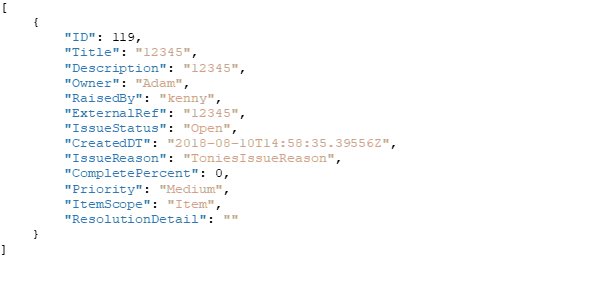Versions
Versions this documentation is relevant for:
- 8.7.0+
List
The Issue – List API call reads existing Issues from Eyelit MES-M. The data can be filtered based on the parameters passed in the body/payload of the JSON packet giving the flexibility to search for one or multiple Issues.
Using the Issues – List API call has no impact on the data within the given Eyelit MES-M application, it is read-only.
Figure 1 - Logic within Issues/List API Call

Data Prerequisites
There is no data required in Eyelit MES-M to act as a pre-requisite to make the API call to list Issues. If parameters are passed in through the body that return no valid results, an empty payload will be returned.
Request
Table 1 shows the method and endpoint required to make the API call to list Issues.
Table 1 - Outbound Message Detail for Issues - List
Method | URL Structure | Endpoint |
POST | https://[environment].mestec.net | /api/Issues/List |
The body of the payload should follow the format below.
JSON Structure for Issues List

See Table 2 for information on which fields are optional, the appropriate data types and the mappings to fields in Eyelit MES-M.
Table 2 - Parameter Information for Issues - List
Parameter Name | Data Mapping | Data Type | Mandatory | Case Sensitive | Match Type |
ID | issue.id | NUMBER | Yes | N/A | Exact |
Note: For any fields where the match type is ‘Like’, a percent symbol should be used as a wildcard character to indicate a number of characters within the given string.
Sample Request
See below for sample use cases with examples of the JSON payload format required.
To list Issues where the ID of the issue is 1234:
JSON Sample for Issues List Request B

Response
When using the Issues – List API call, if any data has been found in Eyelit MES-M that meets the parameter values passed in the original payload, a JSON payload will be returned containing data in the following structure:
JSON Structure for Issues List
 Sample Response
Sample Response
See below for sample use cases with examples of the JSON payload format returned.
No results were found that matched given parameters:
JSON Sample for Issues List Response A

Issue found that matched given parameters:
JSON Sample for Issues List Response B
 Upsert
Upsert
When Issue ID is provided, The Issue – Upsert API call checks if an Issue with the given ID already exists. If it does, appropriate fields are updated in the matching issue in Eyelit MES-M.
When the Issue ID is omitted, a new Issue will be created.
Figure 2 - Logic within Issue/Upsert API Call

Data Prerequisites
The following data entities must exist if they are referenced in an upsert call.
- Issue Type
- Owner (User Account)
- Raised By (User Account)
- Issue Status
- Issue Reason
- Issue Priority
- Team
- Resolution Type
- Item Scope
Request
Table 3 shows the method and endpoint required to make the API call to upsert Issue.
Table 3 - Outbound Message Detail for Issue - Upsert
Method | URL Structure | Endpoint |
PUT | https://[environment].mestec.net | /api/Issue/Upsert |
The body of the payload should follow the format below.
 See Table 4 for information on which fields are optional, the appropriate data types and the mappings to fields in Eyelit MES-M.
See Table 4 for information on which fields are optional, the appropriate data types and the mappings to fields in Eyelit MES-M.
Table 4 - Parameter Information for Issue - Upsert
Parameter Name | Data Mapping | Data Type | Mandatory | Case Sensitive | Match Type |
ID | issue.id | NUMBER | No | N/A | Exact |
IssueType | issuetype.name | VARCHAR2(50) | No | No | Exact |
Title | issue.title | VARCHAR2(100) | No | N/A | N/A |
Description | issue.description | VARCHAR2(2000 BYTE) | No | N/A | N/A |
Owner | useraccount.username | VARCHAR2(50) | No | No | Exact |
ExternalRef | issue.externalref | VARCHAR2(20) | No | N/A | N/A |
IssueStatus | issuestatus.status | VARCHAR2(20) | No | No | Exact |
ClosedDT | issue.closeddt | TIMESTAMP(6) | No | N/A | N/A |
IssueReason | issuereason.reason | VARCHAR2(20) | No | No | Exact |
Qty | issue.quantity | NUMBER(5) | No | N/A | N/A |
Team | team.name | VARCHAR2(50) | No | No | Exact |
DueDT | issue.duedt | TIMESTAMP(6) | No | N/A | N/A |
IssueParentID | issue.issueparentid | NUMBER(10) | No | No | Exact |
ResolutionType | issueresolutiontype.resolutiontype | VARCHAR2(100) | No | No | Exact |
Rank | issue.rank | NUMBER(10) | No | N/A | N/A |
CompletePercent | issue.completepercent | NUMBER(3) | No | N/A | N/A |
Priority | Issuepriority.name | VARCHAR2(100) | No | No | Exact |
ItemScope | issueitemscope.name | VARCHAR2(20) | No | No | Exact |
ResolutionDetail | issue.resolutiondetails | VARCHAR2(2000) | No | N/A | N/A |
Note: For any fields where the match type is ‘Like’, a percent symbol should be used as a wildcard character to indicate a number of characters within the given string.
Sample Request
See below for sample use cases with examples of the JSON payload format required.
To create an Issue.
 To update title and description by ID.
To update title and description by ID.
 Response
Response
When using the Issue – Upsert API call, if an Issue has been Created or Updated a JSON payload will be returned containing data in the following structure:

Sample Response
See below for sample use cases with examples of the JSON payload format returned.
 Delete
Delete
The Issue – Delete API call attempts to delete an Issue. An Issue can be deleted as long as there are no Issue Items linked to the Issue.
Figure 3 shows the logic used within the Issue – Delete API call.
Figure 3 - Logic within Issue/Delete API Call

Data Prerequisites
In order to delete an Issue, the Issue must exist in Eyelit MES-M. The Issue must have no Issue Items linked.
Request
Table 5 shows the method and endpoint required to make the API call to delete an Issue.
Table 5 - Outbound Message Detail for Issue - Delete
Method | URL Structure | Endpoint |
DELETE | https://[environment].mestec.net | /api/Issue/Delete |
The body of the payload should follow the format below.

See Table 7 for information on which fields are optional, the appropriate data types and the mappings to fields in Eyelit MES-M.
Table 7 - Parameter Information for Issue - Delete
Parameter Name | Data Mapping | Data Type | Mandatory | Case Sensitive | Match Type |
ID | issue.id | NUMBER | No | N/A | Exact |
Note: For any fields where the match type is ‘Like’, a percent symbol should be used as a wildcard character to indicate a number of characters within the given string.
Sample Request
See below for sample use cases with examples of the JSON payload format required.
Delete by ID

Response
When using the Issue – Delete API call, if an Issue has been Deleted a null JSON payload will be returned.





